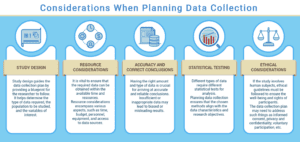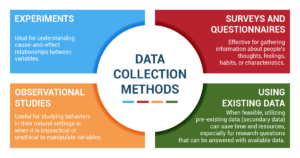Whether you’re aware of it or not, you engage in planning and data collection in various aspects of your life, and understanding its significance can empower you to make more informed decisions and unlock a world of possibilities.
Picture this: you’re organizing a memorable party with your friends.🎉 You want it to be epic, with all the right elements to create an unforgettable experience. So, before you start the preparations, what’s the first thing you do? 🤔You create a detailed plan! You consider the number of guests, their preferences, and the party theme. You carefully think about the music, decorations, and activities that will make your party a hit. Why? Because without a well-thought-out plan, you risk missing key elements or having a lackluster event that leaves your guests unimpressed.
But the planning doesn’t end there. As you gather all the necessary supplies and materials, you’re also engaging in data collection. You compare prices, read reviews, and analyze the quality of products. You make informed choices based on the information you gather, ensuring you get the best value, quality, and overall experience for your party.🌟💎
Planning and data collection play a pivotal role in achieving success, and the same principles apply to statistical studies.

Why Is it Important to Know What Kind of Data We Need When Planning our Study?
- Study design: Study design guides the data collection plan by providing a blueprint for the researcher to follow.
- It helps determine the type of data required, the population to be studied, and the variables of interest.
- It defines the scope, time frame, and overall objectives of the research, which directly influence the decisions made in the data collection plan:
- Specifies the practical steps and procedures to collect the required data
- Determines how the data will be collected
- What tools or instruments will be used
- The sample size needed
- Resource considerations: It is vital to ensure that the required data can be obtained within the available time and resources. These considerations significantly influence the feasibility and practicality of the data collection plan. Resource considerations include:
- Time
- Budget
- Personnel
- Equipment
- Access to data sources
- Accuracy and correct conclusions: Having the right amount and type of data is crucial for arriving at accurate and reliable conclusions. Insufficient or inappropriate data may lead to biased or misleading results. A carefully crafted data collection plan establishes the following:
- Consistent procedures:
- Includes standardized protocols, instructions, and guidelines to ensure uniformity in data collection across different settings, participants, or time points.
- Minimizes potential errors and biases, enhancing the accuracy of the collected data.
- Adequate representation of the target population:
- Increases the accuracy of the conclusions drawn from the data.
- Properly chosen sampling techniques, such as random sampling:
- Minimizes selection biases, contributing to the accuracy of the study.
- A sufficiently large sample size is important to ensure statistical power and generalizability of the findings.
- Consistent procedures:
- Statistical testing: Different types of data require different statistical tests for analysis. Planning data collection ensures that the chosen methods align with the data characteristics and research objectives.
Different statistical tests have specific assumptions about the data. By considering these assumptions during the data collection planning phase, researchers can ensure that the collected data aligns with the requirements of the selected statistical tests. This helps maintain the integrity and accuracy of the statistical analysis.
- Ethical considerations: If the study involves human subjects, ethical guidelines must be followed to ensure the well-being and rights of participants. Researchers should be mindful of potential cultural biases or stereotypes that may influence data collection and interpretation. The data collection plan may need to address such things as:
- Informed consent
- Privacy
- Confidentiality
- Voluntary participation
Steps to Make a Data Collection Plan
- Identify data needs: Determine the specific data required to address the research question. This involves identifying the variables of interest, including independent and dependent variables.
- Independent variable: The independent variable is something that is purposely changed or controlled in an experiment. It is the thing you are testing or trying out to see how it affects something else. For example, if you’re testing how different amounts of sunlight affect plant growth, the amount of sunlight would be the independent variable because you can control how much sunlight the plants receive.
- Dependent variable: The dependent variable is the result or the outcome that you measure or observe in an experiment. It is the thing that changes as a result of what you did with the independent variable. Using the plant growth example, the plant’s height or the number of leaves would be the dependent variable because we hypothesize that it depends on the amount of sunlight it receives.
- Determine sample size: Decide how many data points (sample size) are needed. A larger sample size increases the confidence and reliability of the results, especially when expecting variability or investigating small effect sizes.
- If you want to be more sure of your results, you need more data. It helps to reduce any random variations or unusual results that could happen by chance. So, by collecting more data, you can be more confident that your findings are accurate and trustworthy.
- If you expect there to be a lot of variability in your data, you need more data. Variability means that the data points can be very different from each other. If you think there will be a lot of variability in your data, having more data can help. By collecting more information, you can account for the differences and make better conclusions.
- If you’re looking for a small effect size, you need more data. Effect size is about how strong or noticeable the relationship or difference between things is. Sometimes, the effect size can be small, meaning it’s not easy to see or measure. With more information, even small effects can become clearer and easier to understand.

Choosing a Data Collection Method Aligned With the Research Question
- Experiments: Ideal for understanding cause-and-effect relationships between variables.
- Let’s say you want to find out if studying with music helps students remember information better. You can design an experiment where you divide students into two groups. One group studies with music, and the other group studies in silence. Then, you test their memory by asking them questions. This method helps you understand if there is a cause-and-effect relationship between studying with music and memory performance.
- Surveys and questionnaires: Effective for gathering information about people’s thoughts, feelings, habits, or characteristics.
- Imagine you want to know what kind of movies your classmates like the most. You can create a survey or questionnaire with questions like “What is your favorite movie genre?” or “Which movie have you enjoyed the most recently?” By collecting responses from your classmates, you can gather information about their preferences, thoughts, and opinions on movies.
- Observational studies: Useful for studying behaviors in their natural settings or when it is impractical or unethical to manipulate variables.
- Let’s say you’re interested in studying how people interact in a park. You can visit the park and simply observe people without interfering with their activities. You might take notes on how they play sports, walk their dogs, or have conversations. This method allows you to understand natural behaviors and patterns in real-life situations.
- Using existing data: When feasible, utilizing pre-existing data (secondary data) can save time and resources, especially for research questions that can be answered with available data.
- Suppose you’re curious about the relationship between the average temperature and ice cream sales in your town. Instead of conducting a new study, you can gather historical data on temperature and ice cream sales from weather records and local shops. By analyzing this existing data, you can determine if there is a connection between temperature and ice cream sales without the need for additional data collection.
Tips and Tricks for Creating a Great Data Collection Plan
- Align with research question: Ensure the plan is designed to collect data that directly addresses the research question.
Example:
Research question: “Does exercise frequency affect academic performance in college students?”
Data collection plan: Design a survey questionnaire that collects information on students’ exercise frequency (number of times per week) and their academic performance (GPA or exam scores). The plan ensures that the data collected directly relates to the research question and provides insights into the relationship between exercise frequency and academic performance. - Tailor to the target population: Consider the characteristics and preferences of the population being studied when selecting data collection methods and sampling strategies.
Example:
Research question: “What are the dietary preferences of elderly individuals living in assisted care facilities?”
Data collection plan: Conduct in-person interviews with elderly residents in assisted care facilities to gather information about their dietary preferences. The plan takes into account the age and potential health considerations of the target population, opting for face-to-face interviews to ensure comfort, ease of communication, and the ability to address any specific dietary needs or restrictions. - Address confounders: Identify potential confounding factors that may influence the results and attempt to control for them during the study design or data analysis.
Example:
Research question: “Does a new training method improve athletic performance in soccer?”
Data collection plan: Randomly assign two groups of soccer players to either the traditional training method (control group) or the new training method (experimental group). Before implementing the training methods, collect baseline data on each athlete’s prior performance to control for their initial abilities. By addressing the potential confounding factor of initial athletic performance, the plan ensures that any differences observed between the groups can be more confidently attributed to the training method rather than individual abilities.
Planning Data Collection for an Athletic Training Statistical Study
 Sasha is a high school student who loves sports. She’s always wondered if there’s a connection between the amount of practice athletes put in and their performance on the field. Some athletes seem to excel because they dedicate so much time to training, while others who don’t practice as much struggle to keep up. Now, she is eager to find out if practice really does make perfect in the world of sports.
Sasha is a high school student who loves sports. She’s always wondered if there’s a connection between the amount of practice athletes put in and their performance on the field. Some athletes seem to excel because they dedicate so much time to training, while others who don’t practice as much struggle to keep up. Now, she is eager to find out if practice really does make perfect in the world of sports.
To answer her burning question, Sasha needs to create a data collection plan. But why is it important to know what kind of data she needs when planning her study? Let’s dive in and explore!
First, Sasha needs to design her study. This means creating a blueprint that outlines the type of data she requires, the specific population of athletes she wants to study, and the variables she is interested in. The study design will guide her data collection plan and ensure she stays focused on her research objectives.
Next, she considers resources. She thinks about the time, budget, and access to athletes and training facilities she has available. It’s crucial to ensure that the data she needs can be obtained within these limitations. By considering resource constraints, she can optimize her study design and data collection process, ensuring practicality and realistic results.
Now, let’s talk about accuracy and drawing correct conclusions. It’s important to have the right amount and type of data to arrive at reliable findings. Insufficient or inappropriate data can lead to biased or misleading results. To avoid this, Sasha’s data collection plan should establish consistent procedures for gathering information. This means using standardized methods and guidelines to ensure that data is collected in a uniform way across different athletes and training sessions. Consistency in data collection helps minimize errors and biases, making her findings more accurate.
Statistical testing is another important aspect. Different types of data require different statistical tests for analysis. When planning her data collection, Sasha must consider the characteristics of her data and choose appropriate methods that align with her research goals. By doing so, she ensures the integrity and accuracy of her statistical analysis.
Last but not least, ethical considerations. If Sasha’s study involves human subjects, she must follow ethical guidelines to protect their well-being and rights. Her data collection plan should address matters like informed consent, privacy, and voluntary participation. Being mindful of potential biases or stereotypes in sports is crucial to ensure fair and unbiased data collection and interpretation.
Now that Sasha has thought about these important concepts, she can look at the steps to create a data collection plan specifically for her sports-related research. First, she identifies the specific data she needs to address her research question. This could include variables like practice time, performance metrics, or specific skills she wants to measure.
Next, she determines the sample size or the number of athletes she’ll include in her study. A larger sample size increases the confidence and reliability of her results, especially when expecting variability or investigating small effect sizes.
Choosing a data collection method aligned with her research question is crucial. Observational studies could involve directly observing athletes during training sessions or games, recording their practice hours, or using performance statistics. Surveys and questionnaires could gather information about athletes’ practice habits, motivation, or attitudes toward training.
When creating her data collection plan, Sasha makes sure it aligns with her research question, tailors to the sports context, addresses potential confounding factors, and considers all other necessary best practices.